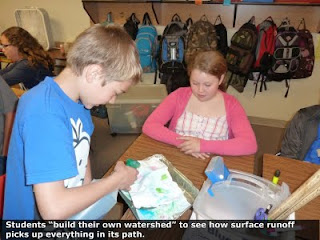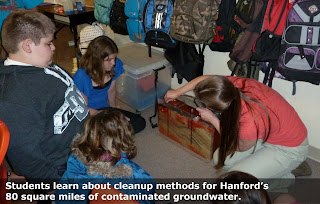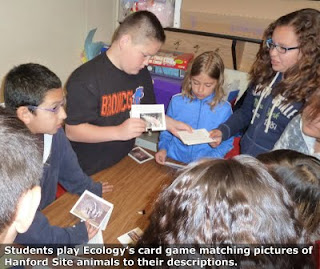 By Erika Bronson, Community Outreach & Environmental Education Specialist, Nuclear Waste Program
By Erika Bronson, Community Outreach & Environmental Education Specialist, Nuclear Waste Program A few weeks ago, I received letters from 50 fifth graders at James McGee Elementary in Pasco. They’d been studying ecosystems, conservation and pollution, and they wanted answers about Hanford. Why is Hanford so contaminated? What is a Vit Plant? How can radiation be captured in glass?
So, on June 1st, I visited the classrooms of two teachers: Mrs. Palomarez and Mrs. Kopf. First, their students wowed me with what they’d learned about ecosystems and pollution. Too much fertilizer on lawns and crops can speed up algae growth in surface waters. Removing a species from an ecosystem impacts other life in that system. Only rain should go in the storm drain, and so on.
Then, I showed them a slideshow on the Columbia River watershed and Hanford history and cleanup. We finished our session playing Ecology’s card game matching descriptions of animals on the Hanford Site to their pictures, trying out Hanford groundwater cleanup methods on Ecology’s model, and playing Bechtel’s WTP 2020 educational video game about the Vit Plant (also known as the Waste Treatment Plant).
Continuing the conversationOne student commented that he couldn’t believe all he had to do was write a letter to get someone from Hanford to come to his class. Surprised by the power of his own words, he sincerely appreciated that someone heard his voice and took action. Some students asked if they could continue to write to me over the summer and have their parents drop off their letters on the way to work. Why not?
The Hanford community often feels like an echo chamber in which all the same voices are heard. Though a diverse chorus, we’re always hoping to get more people in on the conversation. The genuine interest these kids showed in Hanford and the health of our environment demonstrated to me that youth can engage, and intelligently at that.
Some DO stay engagedAs I was writing this, I checked Ecology’s Hanford Education & Outreach Facebook page and discovered 5 new “likes,” two of which were University of Washington students whom I met through service-learning projects. Both promoted a public meeting to fellow students and one went on to write a glossary of terms related to Hanford’s underground tank waste (I’ll be posting it soon).
Some question the ongoing benefits of educational outreach and service learning, claiming it’s a waste of time and money. But Hanford cleanup needs funding for at least another 41 years, and we need informed people to continue working on and caring about it until then and beyond. Educating today’s youth prepares them to be tomorrow’s leaders (McGee fifth graders, that means you!).
For more pictures of my visit to McGee, see our Facebook page.




No comments:
Post a Comment